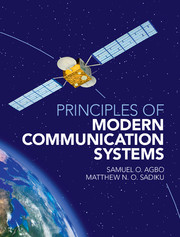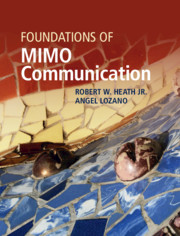Refine search
Actions for selected content:
3527 results in Wireless Communications
3 - Green and Soft Network Design
-
- Book:
- Green and Software-defined Wireless Networks
- Published online:
- 05 April 2019
- Print publication:
- 25 April 2019, pp 61-141
-
- Chapter
- Export citation
2 - Theoretical Framework toward Green Networks
-
- Book:
- Green and Software-defined Wireless Networks
- Published online:
- 05 April 2019
- Print publication:
- 25 April 2019, pp 16-60
-
- Chapter
- Export citation
List of Abbreviations
-
- Book:
- Green and Software-defined Wireless Networks
- Published online:
- 05 April 2019
- Print publication:
- 25 April 2019, pp xiii-xx
-
- Chapter
- Export citation
Index
-
- Book:
- Green and Software-defined Wireless Networks
- Published online:
- 05 April 2019
- Print publication:
- 25 April 2019, pp 287-290
-
- Chapter
- Export citation
4 - Energy-Efficient Signaling Design and Resource Management
-
- Book:
- Green and Software-defined Wireless Networks
- Published online:
- 05 April 2019
- Print publication:
- 25 April 2019, pp 142-181
-
- Chapter
- Export citation
Frontmatter
-
- Book:
- Green and Software-defined Wireless Networks
- Published online:
- 05 April 2019
- Print publication:
- 25 April 2019, pp iii-vi
-
- Chapter
- Export citation
1 - Introduction
-
- Book:
- Green and Software-defined Wireless Networks
- Published online:
- 05 April 2019
- Print publication:
- 25 April 2019, pp 1-15
-
- Chapter
- Export citation
Preface
-
- Book:
- Green and Software-defined Wireless Networks
- Published online:
- 05 April 2019
- Print publication:
- 25 April 2019, pp xi-xii
-
- Chapter
- Export citation

Green and Software-defined Wireless Networks
- From Theory to Practice
-
- Published online:
- 05 April 2019
- Print publication:
- 25 April 2019

Principles of Modern Communication Systems
-
- Published online:
- 01 February 2019
- Print publication:
- 06 February 2017
-
- Textbook
- Export citation

Foundations of MIMO Communication
-
- Published online:
- 10 December 2018
- Print publication:
- 06 December 2018
2 - A signal processing perspective
- from Part I - Wireless Communication Theory
-
- Book:
- Foundations of MIMO Communication
- Published online:
- 10 December 2018
- Print publication:
- 06 December 2018, pp 57-130
-
- Chapter
- Export citation
Appendix C - Random variables and processes
- from Appendices
-
- Book:
- Foundations of MIMO Communication
- Published online:
- 10 December 2018
- Print publication:
- 06 December 2018, pp 661-673
-
- Chapter
- Export citation
9 - MU-MIMO with linear transceivers
- from Part III - Multiuser MIMO
-
- Book:
- Foundations of MIMO Communication
- Published online:
- 10 December 2018
- Print publication:
- 06 December 2018, pp 497-577
-
- Chapter
- Export citation
1 - A primer on information theory and MMSE estimation
- from Part I - Wireless Communication Theory
-
- Book:
- Foundations of MIMO Communication
- Published online:
- 10 December 2018
- Print publication:
- 06 December 2018, pp 3-56
-
- Chapter
-
- You have access
- Export citation
Index
-
- Book:
- Foundations of MIMO Communication
- Published online:
- 10 December 2018
- Print publication:
- 06 December 2018, pp 752-764
-
- Chapter
- Export citation
Appendices
-
- Book:
- Foundations of MIMO Communication
- Published online:
- 10 December 2018
- Print publication:
- 06 December 2018, pp 647-648
-
- Chapter
- Export citation
Appendix E - Special functions
- from Appendices
-
- Book:
- Foundations of MIMO Communication
- Published online:
- 10 December 2018
- Print publication:
- 06 December 2018, pp 676-679
-
- Chapter
- Export citation
Part III - Multiuser MIMO
-
- Book:
- Foundations of MIMO Communication
- Published online:
- 10 December 2018
- Print publication:
- 06 December 2018, pp 413-414
-
- Chapter
- Export citation
8 - MU-MIMO with optimum transceivers
- from Part III - Multiuser MIMO
-
- Book:
- Foundations of MIMO Communication
- Published online:
- 10 December 2018
- Print publication:
- 06 December 2018, pp 436-496
-
- Chapter
- Export citation
